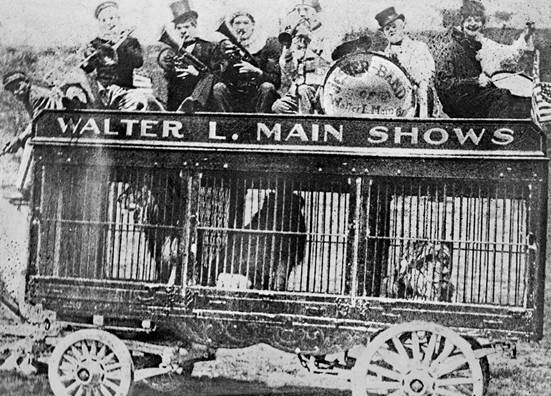
This month, we're going to look at the traveling "Big Top" circus - an immensely popular 19thcentury American innovation.Big circuses would travel thousands of miles a year by rail, bringing pageantry, excitement, and wonders to American towns.Just before World War I, one finally came to Hicksville .Others - but not many - would follow.
Introduction
If you were an American who lived in the latter part of the 1800s, you might awaken one day and see that circus posters now dotted your town.About a week later, the cars of a circus train could be seen in the local freight yard when the sun rose.That morning, there would be a parade; fancifully adorned horses would draw elaborate wagons that were filled with exotic animals, clowns, and musicians.Walking in the parade would be many gaudy and equally exotic people.The parade led townsfolk to what usually was an empty field, but on that day it was filled with tents, including a large Big Top.
Does A Box of Animal Crackers Come To Mind?

The Jester Band of Walter L. Main Shows, location unknown, parading in 1921
thecircusblog.com
This photograph could have been taken in Hicksville ,
which was a stop on the Main Shows' tour that season.
Today's jaded audiences may not realize that circuses long were considered top-tier entertainment, and not just in North America .In the latter 1800s, American circuses had morphed, evolving into larger, glitzier, more spectacular shows, featuring star performers from all over the world.An indication of their popularity is that at the end of the 19thcentury, the Barnum and Bailey show went to Europe and toured there - for five years!Obviously, the demand for circuses was great.Apart from increased population, the chief factor that spurred the growth of circuses was the rise of railroads.
Traditionally, circuses had traveled in caravans of horse-drawn wagons, leaving their winter quarters each spring, and returning to them in the autumn.Any given circus could cover only so much ground each year, for it had to get back to its winter quarters while it still had good weather in which to travel and perform.Over the years, when it was near its base, it had to visit the same towns many times - and when it did, the audiences would be small.The locals had already seen the show many times.
Traveling by train eliminated that problem.A season's performances no longer had to start and end near the winter quarters; each year, there could be different territories, with fresh audiences.Moreover, trains could transport longer tent poles and bigger sheets of canvas than wagons could.That made bigger tents and bigger crowds possible.At each stop on a tour, living quarters and supply cars stayed in the train yard, whereas they formerly had been part of the caravan's parade of wagons.That meant fewer wagons were needed for the parade to the circus grounds, which in turn meant fewer horses, fewer harnesses and horseshoes, less feed to buy, etc.Transporting a circus by rail was easier and more economical.
Long Island had plenty of railroad track and trains, but from the perspective of most traveling circuses, it seemed out of reach: it had no rail connection to the mainland.Thus, in the 1880s, with no big circus on the Island, newspapers would report that people traveled to Port Jefferson, from which they took the ferry to Bridgeport to see a circus.
Of course, the Island was not truly beyond reach if a circus was determined to go there.It was a matter of transporting the train and its contents - animal, vegetable, and mineral - across New York Harbor , or across the Sound.That meant using freight car floats, barges on which railroad tracks had been laid.These were already used by a number of mainland railroads to move freight between New Jersey and, say, Brooklyn .One can imagine that this approach worked better for smaller circuses than for big ones - the latter used as many as seventy railroad cars.

Tug with car float, New York Harbor , c.1925
collections.mcny.org
The Ringling Brothers circus made a tour stop in Flushing in 1891 (perhaps only part of it did; I do not know how much of the show crossed the water).That same season, two other well-known circuses came to the Island : the Frank A. Robbins' Shows and the Walter L. Main Shows.The latter performed at a dozen towns.Incidentally, this was the first year that the Main circus traveled by rail.The year before, it had traveled over dirt roads from Ohio to Massachusetts and back, in a caravan of 120 horse-drawn wagons!


